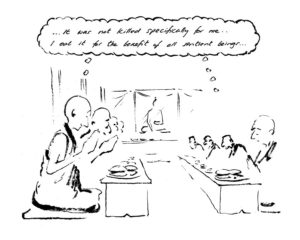Definition of the Week (37) – Conscientiousness
☞ Briefly
Conscientiousness is an awareness not under the control of the afflictions while abiding in enthusiastic effort toward remaining free from afflictions.
It accomplishes virtue and protects the mind from contaminated phenomena.
☞ Elaborately
Definition: Conscientiousness is an awareness that, while abiding with enthusiasm within non-attachment, non-anger and non-ignorance, protects the meditation on virtue and the mind from contaminated phenomena.
It has the function of being the basis for perfectly accomplishing and completing all ordinary and transcendental perfections, and thus is extremely important for accomplishing the grounds and paths.
It is the opposite of recklessness, where one thinks, “It does not matter if my mind is under the control of afflictions,” which leads to all kinds of inappropriate actions.
☞ Divisions: Asanga lists five types of conscientiousness:
- Relating to the past – correcting one’s past actions according to the Dharma.
- Relating to the future – determining to also act in accordance with the Dharma in the future.
- Relating to the present – determining to also act in accordance with the Dharma without forgetfulness in the present.
- Preparatory conscientiousness – adjusting the mind thinking, “If I continue to act in this way then it is unsuitable, but if I engage in these actions then it is appropriate.”
- Immediately following conscientiousness – in dependence on the above abiding in virtuous actions.


